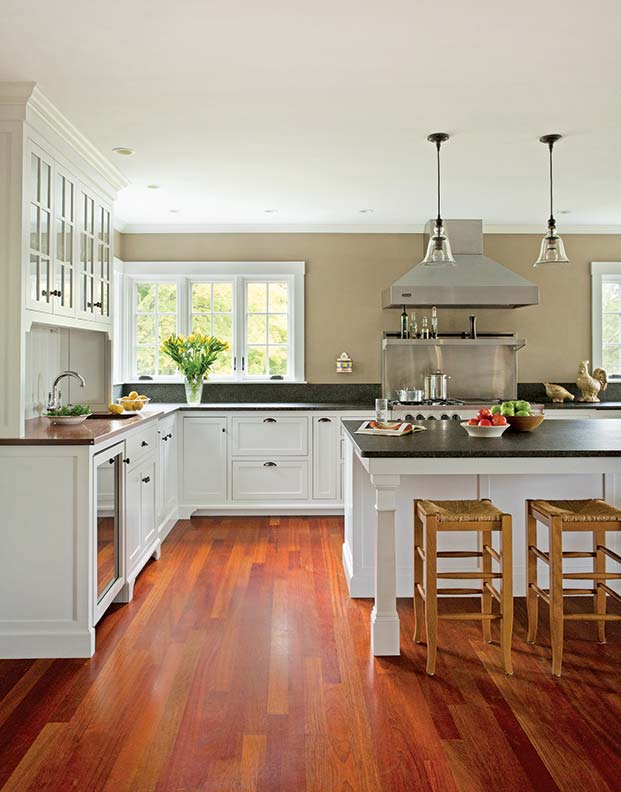
Today, there are plenty of options for environmentally friendly materials and finishes. (Photo: Eric Roth)
Whether the motivation is cutting costs or improving environmental health, the argument for sustainable home design is easily made. As one of the more energy-devouring and heavily used rooms, the kitchen is a good place to begin implementing eco-friendly ideas.
Poor indoor air quality from cooking fumes and off-gasing from flooring, paints, cabinets, and countertops is of immediate concern when looking to go green in the galley. Urea-formaldehyde, a noxious chemical often found in household wood surfaces, is a prime toxin to avoid. Using nontoxic, medium-density fiberboard (MDF) cabinets or, better yet, those made from bamboo, Forest Stewardship Council (FSC)-certified solid wood, or salvaged woods are the best defense against air pollutants. Additionally, energy-efficient ventilation systems, superior insulation, and Energy Star-certified appliances make strides in the right direction.
For Vermont-based architect Sandra Vitzthum, however, sustainable design goes far beyond choice of materials—it’s about using less to get more. It’s a lifestyle. She speaks of the lowest amount of energy needed for the entire life of a building, room, or object— often referred to as “embodied energy.”
Eco-conscious designers like Vitzthum consider the total energy required for the extracting, processing, manufacturing, and delivering building materials to a site. In other words, embodied energy is the sum of all energy required to produce a good, and it’s an important calculation in sustainable kitchen design.. Vitzthum describes a low-embodied-energy project as one that makes use of local materials put together with the least amount of machinery. “It lives for a certain amount of time to perform a certain function, and then deteriorates and is turned back to the earth.” For Vitzthum, sustainable design is about conservation. “It’s about using very, very little energy.”
Massachusetts-based architect Benjamin Nutter shares this philosophy. Currently, he is putting into practice many of its principles with the restoration of a historic Boxford property that includes a 1799 barn, an 1858 carriage house, a 1900 utility shed, and a 1930 wooden water tower. Much of the work relies heavily on indigenous materials—the incorporation of which is something Nutter strongly supports. “A goal of this project has been to include materials and products that are both sustainable within New England and environmentally sensitive,” he says. “Construction methods and materials have been [chosen] with the goal of minimizing long-term maintenance.”
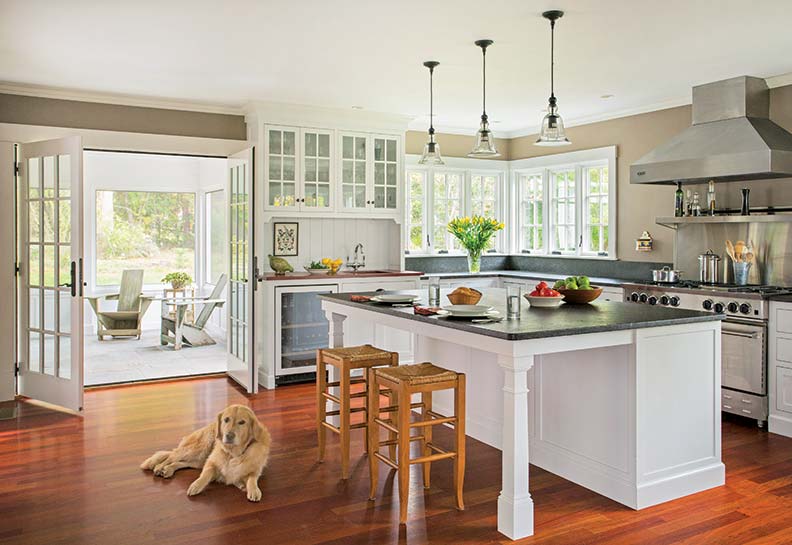
Architect Ben Nutter tries to source local materials for his design projects when possible. The cabinets here are by Jewett Farms. (Photo: Eric Roth)
Usage over time is something Vitzthum also gives thought to. “I think it is pretty important to monitor the electromagnetic field in the house, and try to keep [it] low—it should be healthy for the inhabitants.” Given that today’s society is so mechanized, this can be a challenge. But, she claims, “There are a number of tricks and principles that you can use.”
Examining the “metaphor” for a kitchen is Vitzthum’s first step. Is it a laboratory, as Catharine Beecher suggested? “Americans have a fascination with gadgets and machines that save time,” notes Vitzthum. “The first thing in creating a sustainable kitchen is to examine the metaphor and determine if there is something that is more sustainable.” In other words, could the kitchen be something other than a laboratory?
Thinking of the kitchen as a hearth is a more sustainable approach, according to Vitzthum, who always asks the question: What can be done to make a kitchen more hearth-like? “Think of it as a room for living, focused on gathering together around a table or a workspace. The big picture is the first thing to look at.” In her big picture, people are doing more things by hand.
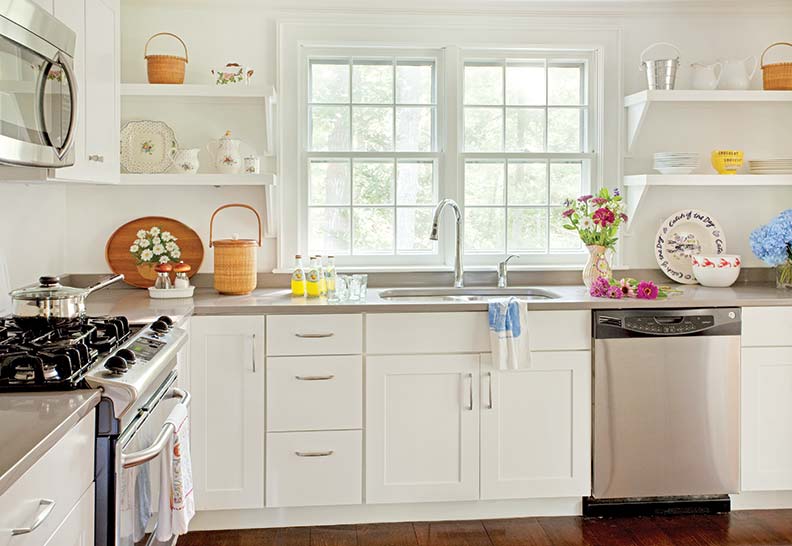
Simple open shelving, reclaimed flooring, and energy-efficient appliances create a sweet and sustainable kitchen.
“There are a lot of arguments for Energy Star appliances,” says Vitzthum, “and there are some very good products on the market.” Appliances approved by the Environmental Protection Agency’s Energy Star program use 10 to 50 percent less energy and water than standard models. But Vitzthum advocates for getting rid of some appliances altogether, and points a sharp finger at the dishwasher, which consumes the most amount of energy in a kitchen. She advises forgoing duplicate appliances and notes that speed ovens can be viewed as eco-friendly, as they cook quickly and use less energy. “Making the machinery and then throwing it away in 10 to 15 years is itself not sustainable,” she says. When it comes to choosing what sacrifices to make in the name of sustainability, Vitzthum admits, “These are difficult and unpopular questions.”
Nutter answers some of those questions. In the Boxford home, a cooking fireplace, beehive oven, and 1790 hearth take center stage in the original kitchen, while an extension features a fully functional 19th-century wood-burning cast iron stove that the client intends to use for cooking. Electricity generated from a new photovoltaic array and on-site gray water disposal are important features of the self-sustaining property.
Vitzthum advises keeping the kitchen a cozy size—a smaller space fills more readily with natural light, which in turn cuts down on energy use. A room 14′ wide with cabinetry on either side, plus a good-sized island, makes for a bright room, she explains. Additionally, picture windows, skylights, and reflective surfaces obviate the need for electrical lighting during the day.
Both designers make use of natural wood for cabinetry and local stone for countertops. “There are also a lot of good new composite materials,” notes Vitzthum. “Recycled glass, bamboo, tiles, Caesarstone, even recycled paper products can be used for some counters.” (It should be noted that bamboo, though highly renewable in terms of its fast growth rate, presents concerns, including urea-formaldehyde in the adhesive used in many bamboo products and the energy-intensive shipping required for its import. Plus, high demand for it has led to China’s clear-cutting of forests and an increased use of fertilizers and pesticides.)
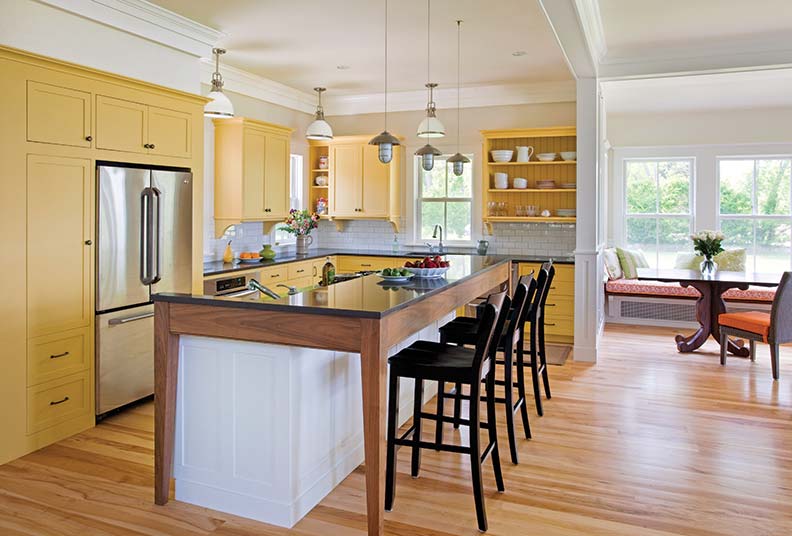
Designing a kitchen with plenty of natural light can help cut down on the amount of electricity used.
Vitzthum uses siltstone and slate quarried in Vermont, and some granite, though she notes, “the granite industry is so global now, you have to ask whether or not it’s a good idea to ship it across the world.” Instead, she recommends using salvaged, reclaimed, or retrofitted items.
Nutter employs similar materials and points to two noteworthy resources: Nor’ East Architectural Salvage in South Hampton, New Hampshire, and Morin’s Fine Furniture & Refinishing in Lewiston, Maine. “It’s helpful for our clients to know about the variety of sustainable design opportunities that are available to them,” notes Nutter. “In New England, we can tap into both recycled and new products that are readily available.” Oak, spruce, and pine beams and posts; pine flooring, sheathing, cabinetry, trim, and paneling; restored brick; wrought iron hardware; and interior light fixtures are among the many materials he sources locally. He also uses elements from the site and/or the existing home; the Boxford property’s kitchen includes original flooring, sheathing, roof purlins, structural beams, radiators, and fieldstone.
“The emphasis [is on] local, sustainable ingredients,” says Vitzthum. For dry areas, she says maple makes an excellent countertop. If using imported wood, it should be sustainable and FSC-certified. “That’s very important,” she stresses. Any wood boasting the FSC certification adheres to rigorous standards for harvesting, forest management, and shipping.
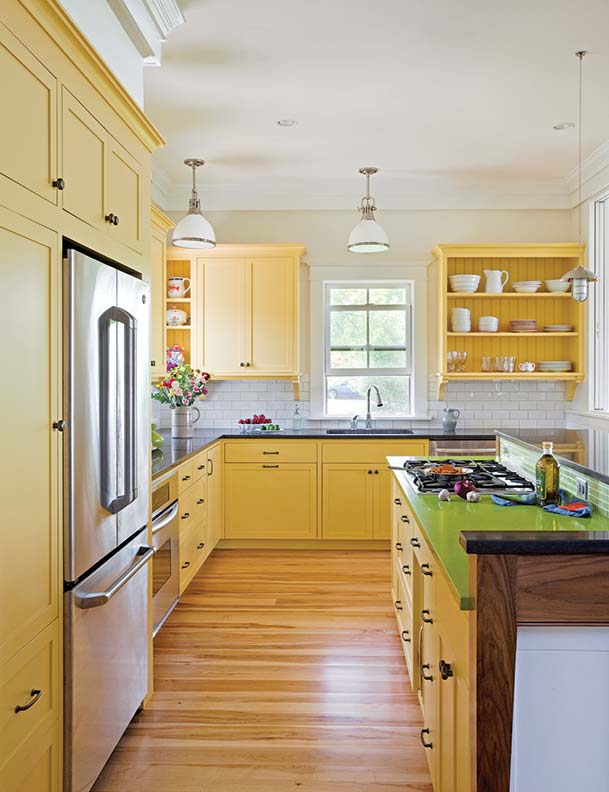
Milk paint and other zero-VOC paints create a greener, healthier indoor environment.
“I like to use a lot of butternut in Vermont kitchens,” says Vitzthum. “It’s a beautiful local hardwood used primarily for cabinetry.” Cork also makes a wonderful floor, though it’s usually imported. However, it is a quickly regenerating product, which is a plus. Vitzthum often uses local maple or heart pine for flooring. Marmoleum—linoleum that is bio-based, highly durable, non-toxic, anti-microbial, and easy to maintain—is another good flooring option.
In terms of finishes, gases emitted from paints, wood preservatives, and other sources have short- and long-term health effects. Green products like eco-safe, VOC-free paints reduce exposure to those pollutants. Materials that have low embodied energy are, again, ideal. Vitzthum prefers oil finishes (including vegetable oil). She sources from Vermont Natural Coatings, which uses whey protein—a byproduct of cheese making—to displace toxic ingredients found in traditional finishes. “They are really, really good products.” She and Nutter both like tung oil for floors. “It’s very durable and better than polyurethane,” says Vitzthum.
All told, the idea is to view the kitchen as part of a larger cycle—from garden to kitchen to compost. When possible, Vitzthum suggests locating the kitchen toward the back of the house where access to the backyard is easier. She also recommends having a garden sink somewhere between the kitchen and the garden. Nutter, too, works with the connection between kitchen and environment—he has designed a composting station composed of a simple hole in the countertop plugged with a circle of salvaged wood, below which sits a container ready for food scraps.
“For me,” says Vitzthum, “it’s really important that sustainability is more than just [what] is in the media right now.” Energy-saving appliances and informed choice of materials help, but for her the real question is, “How does the person live?” Nutter has similar ideas. During initial conversations with clients, he asks them to “consider what can be done, and then consider the source.”







